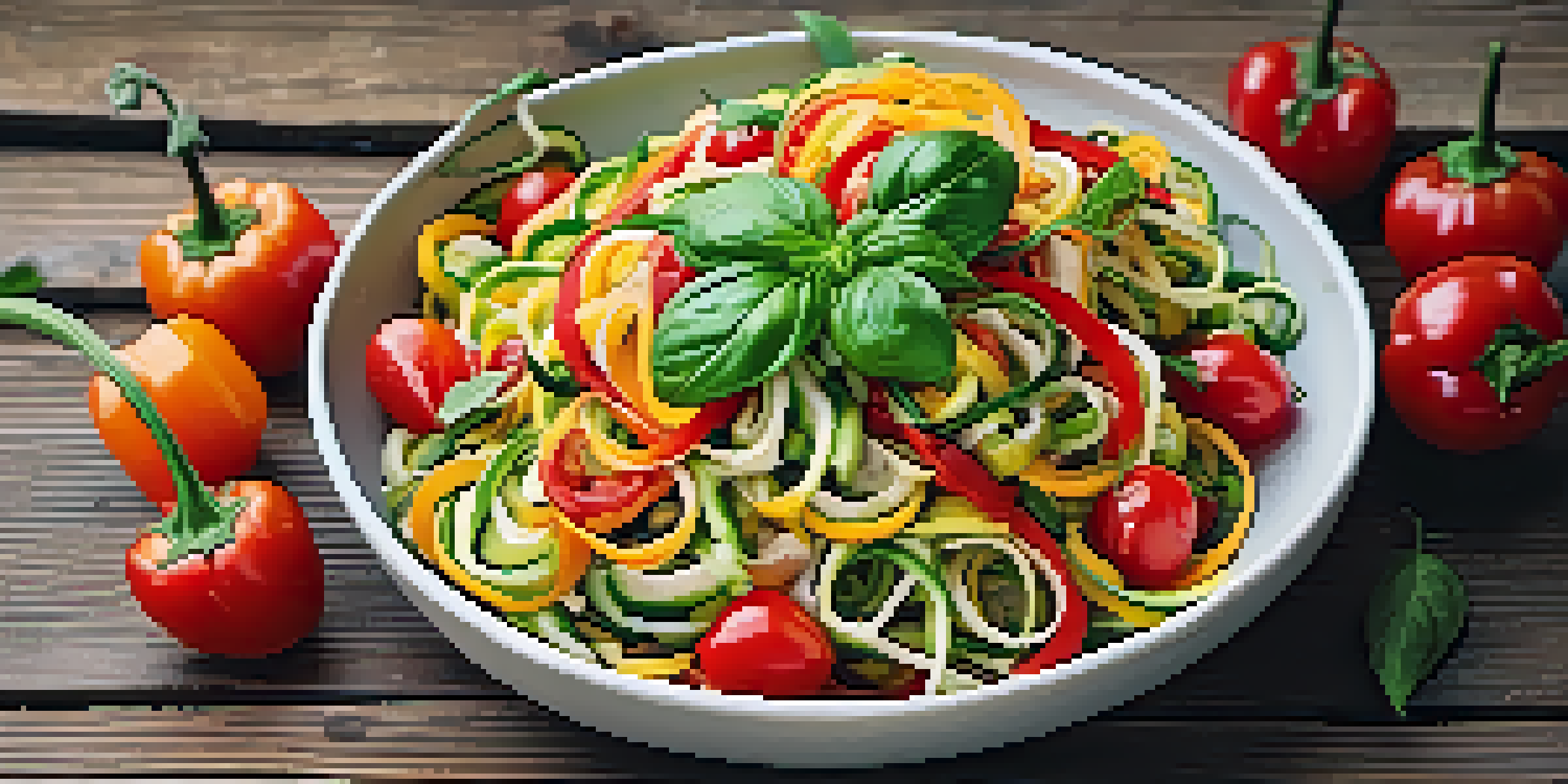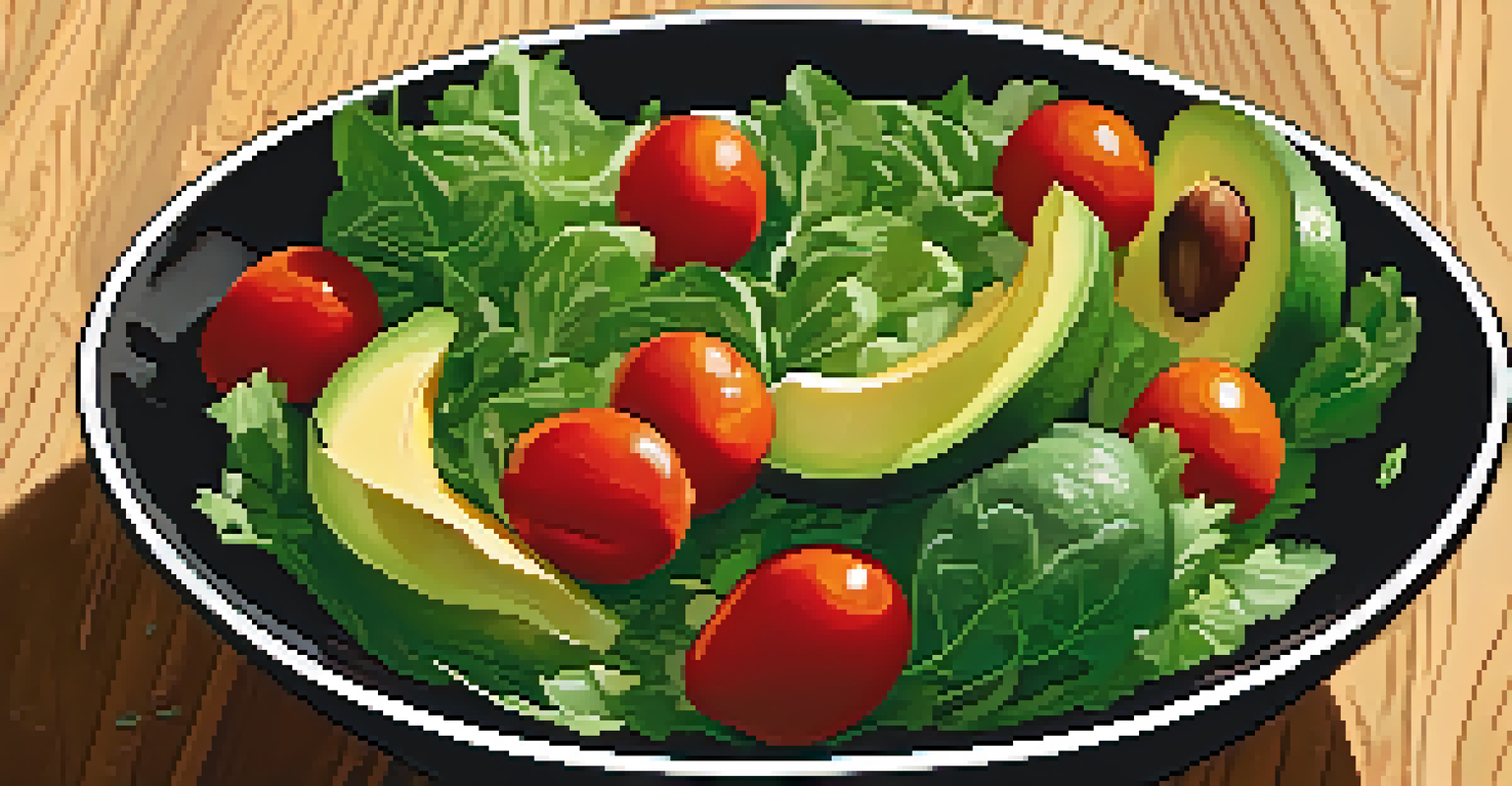Exploring Raw Food Trends in Gourmet Culinary Innovation

The Rise of Raw Food in Gourmet Cuisine
In recent years, raw food has gained significant traction in the gourmet culinary scene. Chefs and food enthusiasts alike are embracing the idea that uncooked ingredients can deliver vibrant flavors and essential nutrients. This trend reflects a broader shift towards health-conscious eating, where the emphasis is on freshness and quality over traditional cooking methods.
Let food be thy medicine and medicine be thy food.
The incorporation of raw ingredients allows chefs to showcase the natural textures and tastes of fruits, vegetables, nuts, and seeds. For instance, a raw zucchini noodle dish can provide a satisfying crunch while maintaining all its vitamins and minerals. This innovative approach not only elevates dishes but also invites diners to experience food in its purest form.
Moreover, the rise of raw food aligns with sustainable practices, as it often involves less energy consumption in cooking. As a result, gourmet restaurants are increasingly crafting menus that highlight raw dishes, demonstrating how culinary innovation can intersect with environmental consciousness.
Key Ingredients in Raw Food Gourmet Dishes
Raw food gourmet cuisine relies heavily on a variety of fresh and unprocessed ingredients. Staples like avocados, sprouted grains, and seasonal vegetables are essential for creating vibrant and nourishing dishes. These ingredients not only provide essential nutrients but also add unique flavors and textures that can excite the palate.

One popular ingredient in raw food is the nut, often used in creative ways to mimic textures found in traditional dishes. For example, cashew cream can be transformed into a decadent sauce that rivals dairy-based options. This versatility highlights how raw food can offer alternatives without sacrificing taste or indulgence.
Cultural Influences Shape Raw Cuisine
Global culinary practices inspire the incorporation of fresh, raw ingredients, enriching gourmet dishes with diverse flavors and techniques.
Herbs and spices also play a crucial role in raw culinary creations, enhancing flavors without the need for cooking. A sprinkle of fresh basil or a dash of nutritional yeast can elevate a simple salad into a gourmet experience, showcasing the potential of raw ingredients to shine.
Innovative Techniques for Raw Food Preparation
While raw food may seem straightforward, it often requires creativity and innovative techniques for preparation. Methods like dehydration, cold-pressing, and fermentation are commonly used to enhance flavors and textures without cooking. For instance, dehydrating fruits can intensify their sweetness, making them a delightful addition to gourmet desserts.
The future of food is not just about taste; it's about health, sustainability, and the ingredients that nourish us.
Fermentation, on the other hand, introduces beneficial probiotics while adding complexity to raw dishes. Foods like kimchi or fermented nut cheeses can bring a tangy zest to a meal, making them both flavorful and health-promoting. This technique exemplifies how raw food can be both nourishing and innovative.
Additionally, using tools like spiralizers or mandolins can help chefs create visually stunning presentations. A beautifully arranged plate of raw vegetable ribbons or a colorful fruit tart can turn a simple dish into a feast for the eyes, elevating the overall dining experience.
The Role of Presentation in Raw Food Dining
In gourmet cuisine, presentation is just as crucial as flavor, and raw food is no exception. The vibrant colors of fresh ingredients provide an excellent canvas for artistic plating. Chefs often use contrasting textures and shapes to create visually appealing dishes that entice diners from the moment they arrive at the table.
For example, a raw food dish might feature a rainbow of diced vegetables arranged in a spiral pattern, accompanied by a drizzle of vibrant dressing. This attention to detail not only highlights the ingredients but also enhances the overall dining experience, making it memorable.
Raw Food Elevates Gourmet Cuisine
The rise of raw food highlights a shift towards fresh, health-conscious dining, showcasing the natural flavors and nutrients of uncooked ingredients.
Moreover, the use of natural elements like edible flowers or microgreens can add an extra touch of elegance. This focus on aesthetics reinforces the idea that raw food can be gourmet, challenging the perception that uncooked meals lack sophistication.
Health Benefits of Raw Food in Gourmet Offerings
One of the most compelling reasons for the popularity of raw food in gourmet cuisine is its health benefits. Raw ingredients are often packed with vitamins, minerals, and enzymes that can be diminished through cooking. This means that diners not only enjoy delicious meals but also gain essential nutrients that support overall health.
Incorporating more raw foods can lead to increased energy levels, improved digestion, and enhanced skin health. For instance, a raw salad loaded with leafy greens, seeds, and a zesty dressing can provide a refreshing and nourishing meal option that leaves diners feeling invigorated.
Moreover, the emphasis on whole, unprocessed foods aligns with a growing trend toward mindful eating. By savoring the flavors and textures of raw dishes, diners become more aware of their food choices, fostering a deeper connection to what they consume.
Cultural Influences on Raw Food Trends
The emergence of raw food in gourmet cuisine is also influenced by various cultural practices around the world. Many traditional diets, such as those in Japan or certain regions of the Mediterranean, emphasize fresh, raw ingredients. This cultural appreciation for whole foods can inspire chefs to incorporate techniques and flavors from diverse culinary backgrounds into their raw offerings.
For example, sushi, often enjoyed raw, showcases the beauty of fresh fish and vegetables, while Mediterranean mezze plates highlight the use of fresh herbs and vegetables. These cultural elements can elevate raw food dishes, infusing them with global flavors that resonate with diners.
Health Benefits of Raw Ingredients
Raw foods are rich in essential nutrients, contributing to increased energy, improved digestion, and overall wellness.
Additionally, the fusion of raw food with different culinary traditions allows chefs to create innovative dishes that appeal to a wider audience. This blending of cultures not only enriches the dining experience but also promotes a sense of inclusivity and exploration in gourmet cuisine.
The Future of Raw Food in Gourmet Culture
As the culinary landscape continues to evolve, raw food is likely to play an increasingly important role in gourmet culture. With a growing focus on health, sustainability, and innovation, chefs are likely to experiment more with raw ingredients and techniques. This trend paves the way for exciting new dishes that challenge traditional notions of gourmet dining.
Moreover, as consumers become more educated about the benefits of raw food, demand for these offerings is expected to rise. Restaurants may respond by expanding their raw menus and incorporating more plant-based and gluten-free options, catering to a diverse range of dietary preferences.

In this ever-changing culinary world, raw food stands out as a vibrant and dynamic trend that not only celebrates the beauty of fresh ingredients but also pushes the boundaries of gourmet innovation. The future holds exciting possibilities for those willing to embrace the raw food movement.